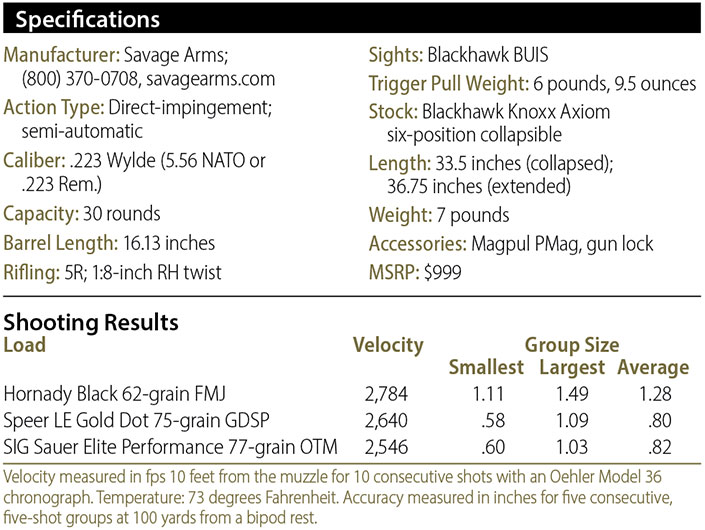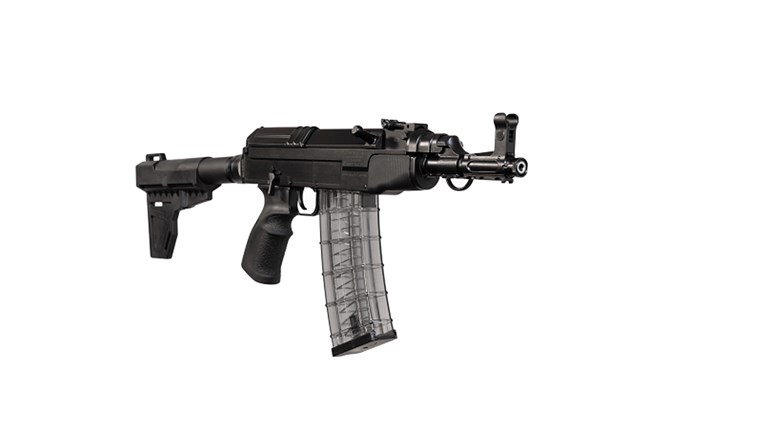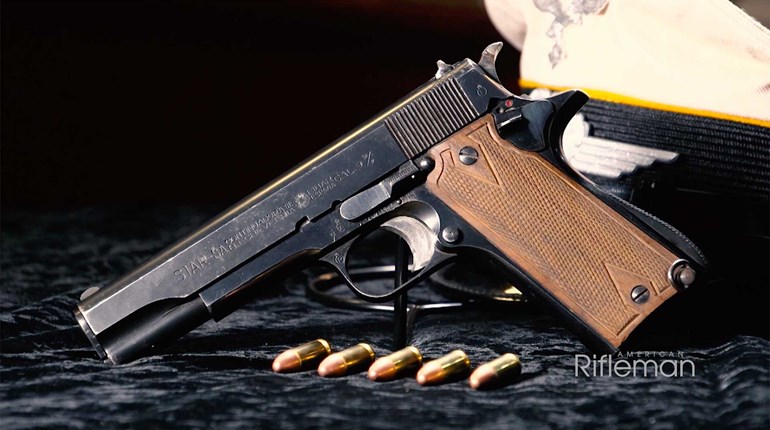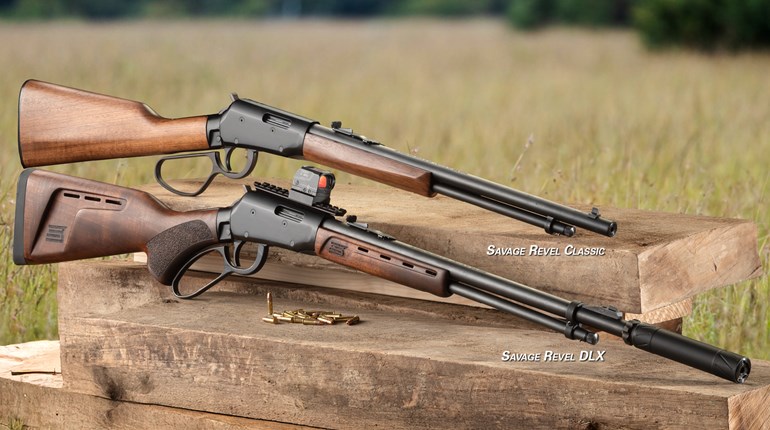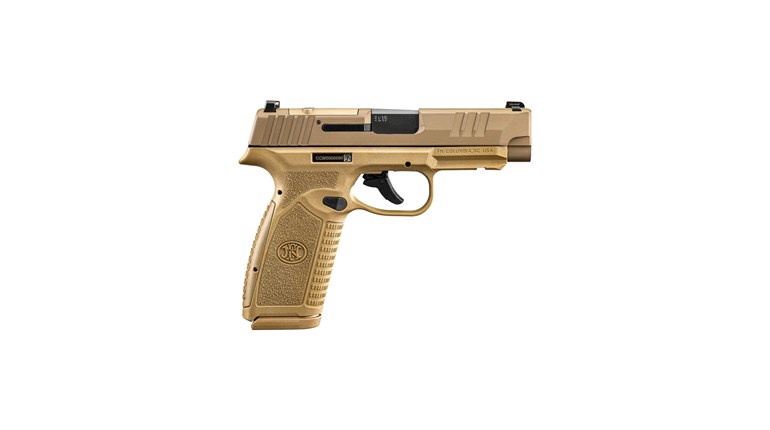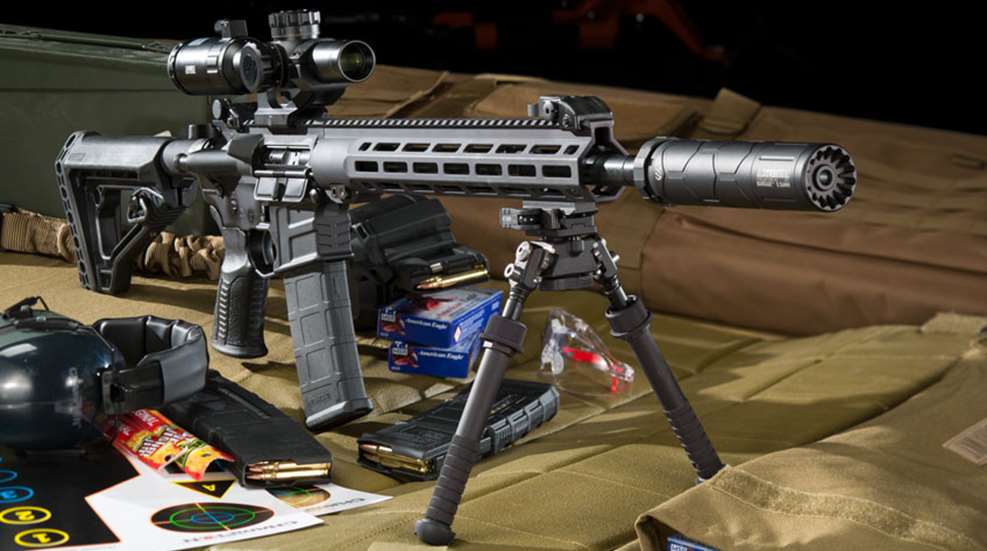
Right now, Savage Arms is in the midst of a brand evolution. For years, the company had a traditional, old-school feel. Even its now-defunct brand logo, the Savage Indian Head, hearkened back to a time when “rifle” and “bolt-action” were synonymous, and the gas-operated semi-automatic was in its infancy. However, all that has changed with the new Savage MSR-15 Recon.
For more than a century, Savage made bolt-action rifles. In fact, the company made great bolt-action rifles, known for their accuracy potential and affordable prices, and it still makes excellent bolt-action rifles. Some of those rifles are even built for tactical applications, such as Savage’s Law Enforcement series.
However, the firearm market has long since evolved beyond bolt-action rifles, and Savage Arms felt it had a great deal to contribute to the development of AR-style semi-automatics. The company took a different tack than other mainstream gun manufacturers on the market, many of which elected to start small by rolling out a single model and building on the success of that first rifle. Savage had a different plan with its MSR-15 Recon and other MSR rifles.
From the start, the company rolled out a sizeable line of AR-10 and AR-15 rifles. In all, four separate models are offered by Savage—two in the smaller AR-15 line and two in the larger AR-10 size. Guns are available in 5.56 NATO, .308 Win. and 6.5 Creedmoor, along with varying designs and barrel lengths. The company is clearly confident in its products, having rolled out severaldifferent options at once. When examining one of these models in particular, the MSR-15 Recon, the reasons why become clear. Savage chose to aim high in the AR market. The company is not participating in the “race to the bottom” that many other manufacturers are trying to win.

“We discovered very early on that we didn’t want to make an ‘M4-gery,’” said Bill Dermody, director of marketing for Savage Arms. “There’s no need out there for that. We spent a lot of time doing formal and informal research, trying to find the white space in the market where there was an opportunity for Savage.”
That research indicated that many AR owners wanted more-accurate rifles and often modified their guns to improve accuracy. This realization guided the direction and focus of the Savage line, particularly in the development of the MSR-15 Recon.
“We’ve been in the long-range and accuracy business for a long time, and when that opening kind of revealed itself, that’s something that we felt we had to take advantage of,” he said.
Of course, the key to producing an accurate rifle starts with an accurate barrel, and Savage is no stranger to the AR barrel business. A little-known fact is that the company has produced AR barrels for other companies in the industry that are now direct competitors to the Savage AR line.
There are a few key features in a Savage barrel. The company uses a technique called 5R rifling, which provides two advantages over more-traditional forms of rifling.

First, the shape of the rifling on the MSR-15 Recon is less square, meaning the angle where the land meets the groove isn’t as sharp as it is on barrels with traditional rifling. This prevents the accumulation of fouling inside those sharp corners, and fouling is what leads to accuracy degradation in traditional barrels. The other benefit of the 5R rifling system is the use of an odd number of lands inside the rifle bore, ensuring that lands are not opposite of other lands. This creates a less-abrupt constriction for the bullet, avoiding unnecessary deformation and ensuring the bullet leaves the bore with as little distortion as possible.
The chamber is another aspect of the accuracy recipe. Traditionally, AR-15 rifles have featured 5.56 NATO chambers, which have the added benefit of being able to handle .223 Rem. cartridges. However, dimensionally speaking, 5.56 NATO and .223 Rem. chambers are slightly different, and that difference prevents 5.56 NATO-chambered rifles from achieving the greatest accuracy possible out of .223 Rem. match ammo.
So, Savage incorporated a .223 Wylde chamber into the design of the MSR-15 Recon. The .223 Wylde isn’t any cartridge you’ll find on the shelf at Walmart, because it doesn’t actually exist. Rather, it’s a design that takes aspects of the 5.56 NATO chamber and the .223 Rem. chamber and combines the best of both. This allows the Savage AR to safely shoot both 5.56 NATO and .223 Rem. while being able to gain advantages offered by .223 Rem. match ammo.
Finally, the Savage MSR-15 Recon barrel features a Melonite finish rather than a more traditional chrome lining. The Savage team preferred Melonite because it allowed them to maintain the dimensional consistency of the barrel, which is much harder to preserve with a plating like chrome. Another benefit of Melonite includes a harder finish that fights wear while maintaining a lower coefficient of friction.
Savage also incorporated a mid-length gas system into the MSR-15 Recon, another departure from the traditional vein of AR rifles. However, the trend lately is going toward mid-length systems, and the benefits seem clear. “A mid-length gas system is really the appropriate length for a 16-inch barrel,” Dermody said. This arrangement prevents the rifle from being overgassed, avoiding the additional wear and tear that comes with introducing too much gas pressure into the operating system.
To improve other aspects of the rifle, Savage has a unique advantage that many other companies don’t. Savage is part of the Vista Outdoor group, and the company was able to work freely with Blackhawk, a sister brand under the Vista umbrella, to produce the AR Blaze trigger included with the rifle. Blackhawk put a great deal of research and science into its AR Blaze triggers, using a proprietary boron treatment on the sear surfaces. Basically, this treatment reduces friction and increases wear resistance in an effort to eliminate creep and smoothen the pull.
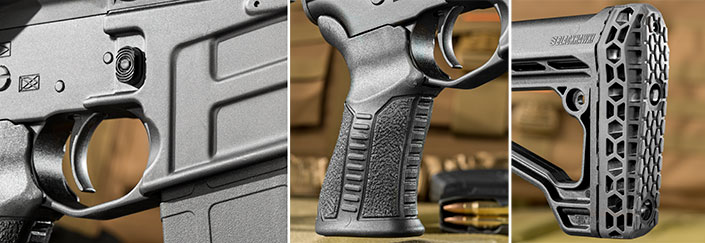
The best way to think about the AR Blaze trigger is simply as a cleaned-up mil-spec unit. It’s better than standard mil-spec options on the market, but there are improved triggers out there. Owners looking for an upgrade will find plenty of aftermarket support.
In addition to the internal upgrades, the Savage MSR-15 Recon also features a number of external improvements over a traditional mil-spec AR, with many of the features supplied by Blackhawk. The company recently unveiled new AR furniture after conducting studies in ergonomics and recoil mitigation through the Knoxx Gen III product-development program.
One of the furniture upgrades on the Recon is the Blackhawk Knoxx Axiom A-Frame Carbine Stock, which includes a number of neat features that make it stand out from the pack. First, the stock has a unique rubberized buttpad designed to cushion recoil. This combined with the Recon’s mid-length system makes for a comfortable shooting experience. The stock also incorporates a forward-adjustment cam that is designed for use while the gun is shouldered. To adjust the length-of-pull, shooters can shoulder the rifle and then use their support hand to squeeze the front lever of the adjustment cam. Six different positions are available on the stock.
The other Blackhawk furniture upgrade on the Savage MSR-15 Recon is the Knoxx AR Pistol Grip. Blackhawk Communications Specialist Kristen Veverka outlined some of the work involved in developing the company’s next-generation AR furniture products. “In the new Blackhawk AR Pistol Grip, we have an improved grip angle and palm swell that should fit every individual,” Veverka said. “We took molds of multiple hands and studied how they interacted with the gun to make ergonomic improvements.”
Too often, it seems like products designed to fit everyone end up fitting no one well, but that’s not the case here. The grip has a nice swell that fills the palm of a shooter’s hand, and there’s a gradual flare outward at the base, which provides a comfortable resting point when shooting off a bench or sticks.
Finally, the slim, freefloat, M-Lok-compatible handguard finishes the external look of the rifle. The handguard is a Savage original, and the company went through a great deal of experimentation and research before coming to the final design.
“We looked at how styles change,” Dermody said. “A lot of it is fashion, to be honest. We actually gave engineering a maximum dimension for that handguard, because fat handguards just aren’t in anymore.”
Regardless of fashion trends, the slim, octagonal handguard on the MSR-15 Recon feels comfortable in the hand. The handguard features a continuous Picatinny rail that matches up with the flattop receiver. Below the flattop, the rail features seven rows of M-Lok attachment points. The transition between each flat face of the handguard is rounded and smooth, providing an easy resting point for a shooter’s support hand. The 13.5-inch length offers real estate for shooters to reach out and mount a supporting grip, allowing them to build a more-stable rifle platform.
However, form follows function, and the hallmark of a quality AR is its ability to run under pressure. Shooting Illustrated had the opportunity to dirty up the rifle on a coyote hunt in northwestern Nevada this past autumn, and it performed without a hitch—despite enduring dusty, windy and freezing conditions on the playa—without cleaning or lubrication.
One note about the MSR-15 Recon is that its barrel’s 1:8-inch twist is tuned for heavier bullets. A variety of .223 Rem. bullet weights were tested through the rifle, and accuracy with several 55-grain options was well below expectations. However, the accuracy potential of the freefloated 5R barrel was outstanding with both 75- and 77-grain bullets, and 62-grain ammo options performed admirably.
It is worth stating that the rifle ate every round without any issues. For general plinking purposes inside of 100 yards, the gun will perform well enough using 55-grain M193 ammo, but it clearly prefers at least 62-grain M855 ammo. Any precision shooting should be performed with heavier-bullet options, and the results will be beyond what one expects from an off-the-shelf AR for less than $1,000.
Savage Arms entered the AR market boldly, and a detailed look at the MSR-15 Recon certainly indicates that the company came into the playing field with some innovative ideas and forward-thinking plans. One thing is clear, though: Savage certainly isn’t the company it used to be. The introduction of the MSR lineup proves that the manufacturer no longer lives in the past or even the present. These guns, along with the company behind it, are fixtures of the future.

